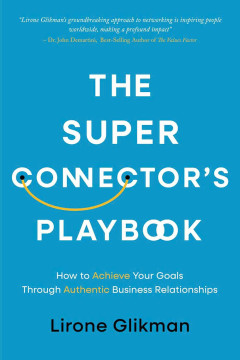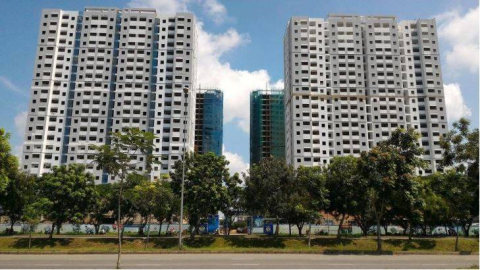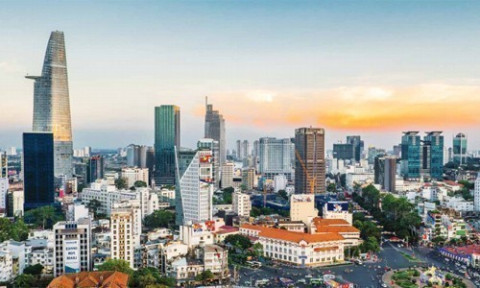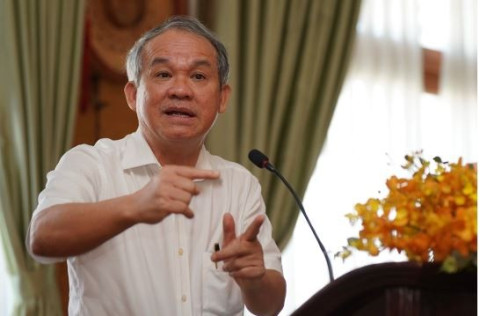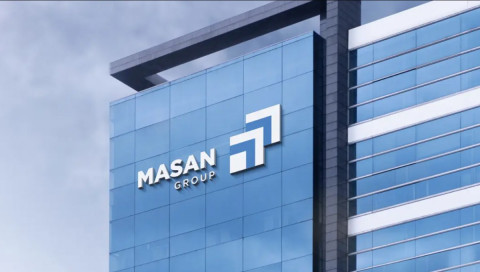Vietnam's industrial real estate market is growing steadily.
- 139
- Entrepreneur
- 15:51 18/10/2023
DNHN - Vietnam's economy is growing steadily due to key market drivers. Principal factors include a young and dynamic labor force, competitive labor costs, an export-oriented economy, and a stable business environment.
Import and export
In 2016, exports of phones and phone components generated 34 billion USD in revenue. Nonetheless, by the end of 2022, this sector had the highest export turnover, reaching 58 billion USD, accounting for 16% of total export turnover and growing 1% during the same period.
Similarly, other high-added-value products such as electronics, computers, and components had an export turnover of $19.1 billion in 2016. By 2022, however, the export value will have reached 56 billion USD; this segment will account for 15% of export turnover and will have grown by 10% compared to the same period in the previous year. Textiles and footwear, two export industries with low added value, account for only 10% and 4% of total export turnover, respectively.
Mr. John Campbell, Deputy Director and Head of Industrial Services at Savills Vietnam stated, "From 2016 to 2022, the export turnover of electronics and computers will increase by 193 percent, while the export turnover of mobile phones will increase by 68 percent. This reflects Vietnam's move up the value chain as an export-oriented economy producing products with high added value."
Invest in production
In the first six months of 2023, foreign direct investment (FDI) in the manufacturing and processing sector accounted for 63% of the total foreign investment capital. The registered capital of 379 new projects is only $5.4 billion. There are 225 existing projects with increased capital totaling $2.1 billion, out of a total of 345 existing projects.
Singapore is one of the countries with the largest investment in Vietnam, accounting for 25 percent of the total investment capital of $1.4 billion. China ranks second in total investment capital, accounting for 23% of total investment capital, behind Hong Kong at 12%.
63% of newly registered manufacturing FDI projects were located in Vietnam's northern region, which attracted 3,4 billion US dollars in FDI. In contrast, the South ranked second with 1,4 billion USD in total investment capital or 27% of the project. Regarding the number of projects, the North ranked first with 238 new projects, followed by the South with 122 and the Central region with 19.
Bac Giang is the province with the highest amount of newly registered FDI capital in manufacturing in the country, with 1.06 billion USD, or 20% of the total investment capital. Binh Phuoc comes in second with 11% of total registered capital worth 577 million USD, followed by Bac Ninh with 9% of total registered capital worth 487 million USD.
In the first half of 2023, Fulian Precision Technology's 621-million-dollar project in Bac Giang, Goerteck (Hong Kong) Co.'s 280-million-dollar project in Bac Ninh, and Boltun Corp & QST International Corp's 165-million-dollar project in Quang Ninh will be the largest investment projects in the Northern region.
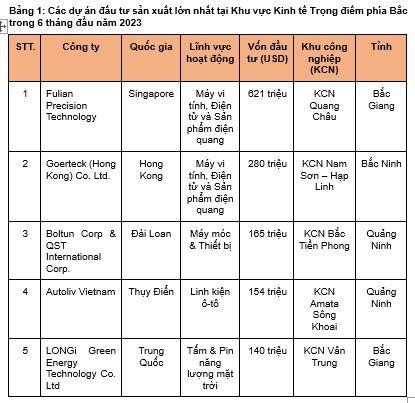
In the South, notable projects include the $500 million Binh Phuoc project of Shandong Haohua Tyre, the $185 million Long An project of Suntory Pepsico Vietnam, and the $163 million Binh Phuoc project of Shandong Haohua Tyre. The CEO of Pandora Production Holdings A/S is Duong.
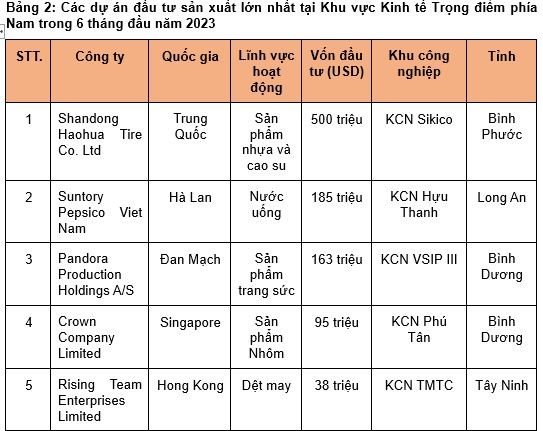
Industrial production index (IIP) and PMI manufacturing index
According to Trading Economics, Vietnam's manufacturing Purchasing Managers' Index (PMI) rose from 48.7 points in July to 50.5 points in August 2023. This is the first growth above the 50-point threshold since February 2023, when output, new orders, and exports all returned to expansion. In addition, purchasing power rose for the first time in six months and to the greatest extent since September 2022.
In August 2023, Vietnam's industrial output increased 2.6% year-over-year, up from 2.3% a month prior, marking the fourth consecutive month of industrial output growth. continues and has the highest rate of expansion. In August, output grew by 3.5%, up from 2.9% in July.
Supply & and operating situation
In 2023, 397 industrial parks (IPs) with a total land area of 122,900 hectares will be established. In operation are 292 industrial parks with a total land area of over 87,100 hectares. Another 106 industrial parks with a total land area of 35,700 hectares are being constructed.
The national occupancy rate for industrial parks exceeds 80%, with key northern provinces reaching 83% and key southern provinces reaching 91%.
The Northern key economic region recorded 68 industrial park projects comprising 12,000 hectares of leased land. The average rental price of land increased by 30% annually, reaching 138 USD/m2/rental period. Tenants in this area primarily operate in the fields of electronics and computers, automobile manufacturing and assembly, and solar energy-related components. Samsung, LG Electronics, Canon, Hyundai, Honda, and Vinfast are examples of notable businesses operating in the North.
The Northern Economic Zone has a developed road network, which strengthens connections between Hanoi and important industrial provinces such as Bac Ninh, Hung Yen, Bac Giang, Hai Duong, Hai Phong, and Quang Ninh. This region has three major ports: Hai Phong Port, Lach Huyen Deep Water Port, and Cai Lan Port, which facilitate access to international markets such as Korea, China, and Taiwan, thereby enhancing the industrial competitiveness of the region.
The key economic region of the South recorded 122 industrial park projects on leased land totaling 24,883 hectares. The average land rental price increased by 15% annually to reach 174 USD/m2/rental period. Tenants are predominantly engaged in the processing of food and beverages, construction materials, textiles, and rubber and plastic goods. LEGO, Suntory PepsiCo, Intel, Unilever, Coca-Cola, and Kumho Tyres are notable tenants.
In terms of infrastructure, the Southern Economic Zone is presently awaiting the completion of Ring Road 3 (2026), Ring Road 4 (2028), and the Ben Luc - Long Thanh Motorway (2026). finished in 2025). Three major bidding packages for Long Thanh International Airport in Dong Nai and Terminal 3 of Tan Son Nhat International Airport in Ho Chi Minh City began on August 31, 2023. Long Thanh International Airport will be constructed in three phases on an area of 5,580 hectares at a total cost of $14 billion. It is anticipated that all phases of the super project will be completed by 2050. Terminal 3 of Tan Son Nhat International Airport is anticipated to open in the second half of 2025 at an estimated cost of USD 451 million.
The future is promising
The improvement in the manufacturing and industrial production PMI bodes well for the market's future. In addition, consulting firms such as Savills are observing a rise in the number of requests and site surveys from multinational manufacturing, logistics, and e-commerce companies, reflecting the rising demand for industrial products.
Vietnam is anticipated to maintain rapid economic growth over the medium term as exports recover; it will also continue to profit from the shift in global manufacturing supply chains to competitive manufacturing hubs in Southeast Asia.
"Vietnam's steady growth can be attributed to a young and dynamic workforce, competitive labor costs, an export-oriented economy, and a stable business environment. Vietnam's active participation in Free Trade Agreements is influenced by its regulations, geographical location, and active participation in Free Trade Agreements. Vietnam has signed 15 Free Trade Agreements and is currently negotiating three more. This is more than the majority of other countries in the region. This demonstrates the impressive global integration of Vietnam and Southeast Asia in general, as noted by Mr. John Campbell.
Future trends
The growth of the industrial sector in the Mekong Delta has reached significant milestones during the years 2022 and 2023. In September 2023, the investor VSSIP began construction on the 900-hectare first project in Can Tho, which is anticipated to be a complex of industrial, high-tech, service, and residential centers. Phase 1 will encompass 293,7 hectares and will require an investment of more than 152 million US dollars. During the construction preparation phase, VSIP invested an additional $7.4 million in the construction of a road connecting the project to U.S. Route 80. Regarding infrastructure, according to the Development Plan for the period 2021 - 2030, with a vision to 2050, the Mekong Delta is expected to develop more infrastructure, thereby laying the groundwork for industrial real estate development. with six motorways totaling 1,166 kilometers in length.
Meanwhile, solar manufacturers observed a shift northward. Three of the top five manufacturing projects in the Northern Key Economic Zone in 2022 were associated with the production of solar energy. Trina Solar is the largest investor in Yen Binh Industrial Park, Thai Nguyen province, with a 275 million USD project. The majority of investors are from China, Hong Kong, and Singapore.
The industrial market landscape is shifting as more investors enter the market. As the manufacturing and logistics industries expand, industrial products such as prefabricated factories, warehouses, multi-story facilities, combined facilities, and temperature-controlled buildings become increasingly diverse. and tailored to your needs.
In only five years, land renters will have more options and will no longer be bound by the standard 50-year land lease term. As a result, there is increased competition among investors, as more prefabricated housing is introduced in key provinces. To attract tenants, industrial parks and ready-built real estate developers must offer value-added services and incentives, such as market entry services, human resources, and legal support. management, management services, sustainability initiatives, and professional industrial real estate agency collaboration.

Mr. John Campbell, Senior Advisor of Savills Vietnam, stated that the Vietnamese Industrial Real Estate market will face certain obstacles in the future.
First, Vietnam's traffic infrastructure remains inferior to that of other countries in the region. Despite the rapid expansion of transport infrastructure, development has not kept pace with economic and social growth. Rapid urban population and freight transport growth is the primary driver of infrastructure demand, while port and seaport capacity has not yet reached its maximum potential.
Second, as Vietnam shifts its focus to attracting high-value-added industries and increasing productivity to be on par with regional competitors, the demand for skilled labor will increase. Although labor costs in Vietnam are only a third of those in China, productivity at the same level is lower.
Thirdly, stringent new fire regulations were implemented at the end of 2022, posing challenges for industrial developers, manufacturers, and logistics companies. Numerous projects have been delayed as a result of the inability of major foreign investors to obtain the necessary certifications.
The expert stated that the Vietnamese government must continue to invest in infrastructure and improve the skills of its labor force to address existing problems and increase productivity and efficiency. Moreover, the promotion of supporting industries, the strengthening of supply chains, the simplification of investment and land use procedures, and the implementation of digitalization are essential aspects of Vietnam's economy.
Nghe Nhan
Related news
- Unitsky String Technologies signs cooperation agreements with three Vietnamese partners, opening a new direction for smart mobility and sustainable development
- When artists do business – livelihood is no poetry!
- Before the D‑day to abolish flat‑rate tax: Fear of technology and costs leave small traders struggling to adapt
- Vietnamese enterprises at a crossroads: the impact of a potential US–China deal
- "Digital technicians" must not be forgotten if Vietnam aims to meet its strategic goals
- HDBank: Impressive profit growth, leading in profitability and advancing international integration
- TNI King Coffee sued for over VND 5 Billion in unpaid debts
- VINASME and Jeonnam Technopark Sign MOU on technology cooperation, human resource training, and trade promotion
- Vietnamese entrepreneurs strengthen ASEAN connectivity in the digital iIntegration era
- Prime Minister: Vietnam aims to become a regional logistics hub
- Vietnam upgraded to Secondary Emerging Market by FTSE Russell
- Hanoi’s economy grows 7.92% in first nine months of 2025, FDI surges nearly threefold
- Vietnam’s strong gdp growth fails to ease labor market distress
- US tariffs on Brazil propel Vietnam’s pangasius into global spotlight
- VietLeap AI Accelerator launches: A strategic springboard for Vietnam’s AI startups
- CICON expands strategic alliances: A new step forward in Vietnam–Korea business connectivity
- What must Vietnamese enterprises do to maintain their position in the global supply chain?
- Vietnam advances cybersecurity law to boost digital sovereignty and business resilience
- Administrative procedures for establishing the national technology exchange reduced to one application set
- Vietnam hits highest FDI inflow since 2009, fuels industrial real estate boom
Đọc thêm Entrepreneur
Billionaire Bezos teaches Vietnamese entrepreneurs: “Don’t do business, be obsessed with customers”
Ranked the world’s fourth-richest person (Forbes, August 2025) with an estimated fortune of $241 billion, billionaire Jeff Bezos created the Amazon legend.
The Super Connector’s Playbook: The art of building soft power in the age of connection
In an era where technology is merely a tool, speed is no longer the ultimate edge, and attention has become the scarcest asset. Extraordinary success belongs not to those who are the smartest, but to those who are the most trusted.
The move of a Chinese businesswoman into Vietnam’s snack market
Recognizing Vietnam’s market potential, Chinese entrepreneur Liu Gengyan aims to develop a professional and distinctive snack store chain in the country.
Who are the two mysterious female tycoons holding 52 million HQC shares?
Two female tycoons have emerged as major shareholders of Hoang Quan Consulting-Trading-Service Real Estate Corporation (HQC), holding a combined 52 million shares, with investments totaling hundreds of billions of VND.
Young entrepreneur Lisa Phan: When you dream and act, nothing is impossible
Lisa Phan believes that a company’s success comes not only from good products and services but also from the way people treat one another.
Chopin: The magical piano – Touching the heart and emotions of the audience
THE YEAR 2024 MARKED THE RETURN OF PIANIST NGUYỄN VIỆT TRUNG WITH A SERIES OF REMARKABLE PERFORMANCES.
Request to thoroughly resolve real estate issues and avoid "criminalization"
The National Assembly requests a thorough resolution of real estate projects entangled with legal issues, avoiding the "criminalization" of economic and civil relations, and clarifying "no legalization of violations."
‘'Bầu Đức'’ and the banana revolution at Hoang Anh Gia Lai
Amid economic challenges, Hoang Anh Gia Lai (HAGL) has staged a strong comeback under the leadership of "Bầu Đức", thanks to banana cultivation.
VINASME Championship SHB Cup 2024 Golf Tournament: Business leaders shine with elite swings
The VINASME Championship SHB Cup 2024 concluded with beautiful memories and success beyond expectations, becoming one of the most memorable golf events of this autumn season.
Daughter of Masan Chairman Nguyễn Đăng Quang plans to purchase 10 million MSN shares
The Vietnamese stock market is abuzz as Nguyễn Yến Linh, daughter of Masan Chairman Nguyễn Đăng Quang, announced her plan to buy 10 million MSN shares between October 29 and November 18, 2024.



